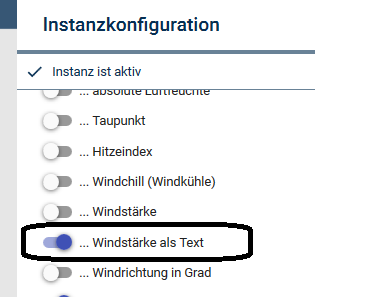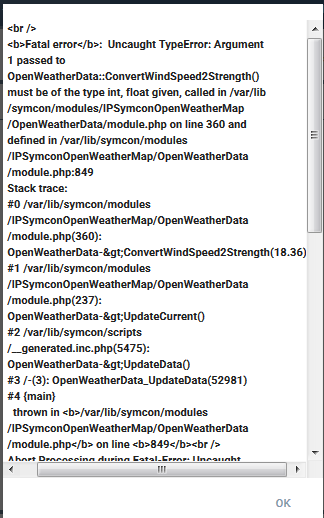Ich hab das alles in einer Datei:
<html>
<script src="https://code.jquery.com/jquery-3.1.1.min.js"></script>
<script src="https://code.highcharts.com/highcharts.js"></script>
<script src="https://code.highcharts.com/modules/windbarb.js"></script>
<script src="https://code.highcharts.com/modules/exporting.js"></script>
<script src="https://highcharts.github.io/pattern-fill/pattern-fill-v2.js"></script>
<script src="https://github.com/highcharts/highcharts/blob/master/js/themes/dark-unica.js"></script>
<div id="container" style="max-width: 800px; min-width: 380px; height: 300px; margin: 0 auto">
<div style="margin-top: 100px; text-align: center" id="loading">
<i class="fa fa-spinner fa-spin"></i> Lade Daten vom Wetterdienst
</div>
</div>
<script>
function Meteogram(xml, container) {
// Parallel arrays for the chart data, these are populated as the XML/JSON file
// is loaded
this.symbols = [];
this.precipitations = [];
this.precipitationsError = []; // Only for some data sets
this.winds = [];
this.temperatures = [];
this.pressures = [];
// Initialize
this.xml = xml;
this.container = container;
// Run
this.parseYrData();
}
/**
* Function to smooth the temperature line. The original data provides only whole degrees,
* which makes the line graph look jagged. So we apply a running mean on it, but preserve
* the unaltered value in the tooltip.
*/
Meteogram.prototype.smoothLine = function (data) {
var i = data.length,
sum,
value;
while (i--) {
data[i].value = value = data[i].y; // preserve value for tooltip
// Set the smoothed value to the average of the closest points, but don't allow
// it to differ more than 0.5 degrees from the given value
sum = (data[i - 1] || data[i]).y + value + (data[i + 1] || data[i]).y;
data[i].y = Math.max(value - 0.5, Math.min(sum / 3, value + 0.5));
}
};
/**
* Draw the weather symbols on top of the temperature series. The symbols are
* fetched from yr.no's MIT licensed weather symbol collection.
* https://github.com/YR/weather-symbols
*/
Meteogram.prototype.drawWeatherSymbols = function (chart) {
var meteogram = this;
$.each(chart.series[0].data, function (i, point) {
if (meteogram.resolution > 36e5 || i % 2 === 0) {
chart.renderer
.image(
'https://cdn.jsdelivr.net/gh/YR/weather-symbols@6.0.2/dist/svg/' +
meteogram.symbols[i] + '.svg',
point.plotX + chart.plotLeft - 8,
point.plotY + chart.plotTop - 30,
30,
30
)
.attr({
zIndex: 5
})
.add();
}
});
};
/**
* Draw blocks around wind arrows, below the plot area
*/
Meteogram.prototype.drawBlocksForWindArrows = function (chart) {
var xAxis = chart.xAxis[0],
x,
pos,
max,
isLong,
isLast,
i;
for (pos = xAxis.min, max = xAxis.max, i = 0; pos <= max + 36e5; pos += 36e5, i += 1) {
// Get the X position
isLast = pos === max + 36e5;
x = Math.round(xAxis.toPixels(pos)) + (isLast ? 0.5 : -0.5);
// Draw the vertical dividers and ticks
if (this.resolution > 36e5) {
isLong = pos % this.resolution === 0;
} else {
isLong = i % 2 === 0;
}
chart.renderer.path(['M', x, chart.plotTop + chart.plotHeight + (isLong ? 0 : 28),
'L', x, chart.plotTop + chart.plotHeight + 32, 'Z'])
.attr({
'stroke': chart.options.chart.plotBorderColor,
'stroke-width': 1
})
.add();
}
// Center items in block
chart.get('windbarbs').markerGroup.attr({
translateX: chart.get('windbarbs').markerGroup.translateX + 8
});
};
/**
* Get the title based on the XML data
*/
Meteogram.prototype.getTitle = function () {
return 'Meteogram für ' + this.xml.querySelector('location name').textContent +
', ' + this.xml.querySelector('location country').textContent;
};
/**
* Build and return the Highcharts options structure
*/
Meteogram.prototype.getChartOptions = function () {
var meteogram = this;
return {
chart: {
renderTo: this.container,
marginBottom: 70,
marginRight: 40,
marginTop: 50,
plotBorderWidth: 1,
height: 270,
alignTicks: false,
scrollablePlotArea: {
minWidth: 720
}
},
defs: {
patterns: [{
'id': 'precipitation-error',
'path': {
d: [
'M', 3.3, 0, 'L', -6.7, 10,
'M', 6.7, 0, 'L', -3.3, 10,
'M', 10, 0, 'L', 0, 10,
'M', 13.3, 0, 'L', 3.3, 10,
'M', 16.7, 0, 'L', 6.7, 10
].join(' '),
stroke: '#68CFE8',
strokeWidth: 1
}
}]
},
title: {
text: this.getTitle(),
align: 'left',
style: {
whiteSpace: 'nowrap',
textOverflow: 'ellipsis'
}
},
tooltip: {
shared: true,
useHTML: true,
headerFormat:
'<small>{point.x:%A, %b %e, %H:%M} - {point.point.to:%H:%M}</small><br>' +
'<b>{point.point.symbolName}</b><br>'
},
xAxis: [{ // Bottom X axis
type: 'datetime',
tickInterval: 2 * 36e5, // two hours
minorTickInterval: 36e5, // one hour
tickLength: 0,
gridLineWidth: 1,
gridLineColor: (Highcharts.theme && Highcharts.theme.background2) || '#F0F0F0',
startOnTick: false,
endOnTick: false,
minPadding: 0,
maxPadding: 0,
offset: 30,
showLastLabel: true,
labels: {
format: '{value:%H}'
},
crosshair: true
}, { // Top X axis
linkedTo: 0,
type: 'datetime',
tickInterval: 24 * 3600 * 1000,
labels: {
format: '{value:<span style="font-size: 12px; font-weight: bold">%a</span> %b %e}',
align: 'left',
x: 3,
y: -5
},
opposite: true,
tickLength: 20,
gridLineWidth: 1
}],
yAxis: [{ // temperature axis
title: {
text: null
},
labels: {
format: '{value}°',
style: {
fontSize: '10px'
},
x: -3
},
plotLines: [{ // zero plane
value: 0,
color: '#BBBBBB',
width: 1,
zIndex: 2
}],
maxPadding: 0.3,
minRange: 8,
tickInterval: 1,
gridLineColor: (Highcharts.theme && Highcharts.theme.background2) || '#F0F0F0'
}, { // precipitation axis
title: {
text: null
},
labels: {
enabled: false
},
gridLineWidth: 0,
tickLength: 0,
minRange: 10,
min: 0
}, { // Air pressure
allowDecimals: false,
title: { // Title on top of axis
text: 'hPa',
offset: 0,
align: 'high',
rotation: 0,
style: {
fontSize: '10px',
color: Highcharts.getOptions().colors[2]
},
textAlign: 'left',
x: 3
},
labels: {
style: {
fontSize: '8px',
color: Highcharts.getOptions().colors[2]
},
y: 2,
x: 3
},
gridLineWidth: 0,
opposite: true,
showLastLabel: false
}],
legend: {
enabled: false
},
plotOptions: {
series: {
pointPlacement: 'between'
}
},
series: [{
name: 'Temperature',
data: this.temperatures,
type: 'spline',
marker: {
enabled: false,
states: {
hover: {
enabled: true
}
}
},
tooltip: {
pointFormat: '<span style="color:{point.color}">\u25CF</span> ' +
'{series.name}: <b>{point.value}°C</b><br/>'
},
zIndex: 1,
color: '#FF3333',
negativeColor: '#48AFE8'
}, {
name: 'Precipitation',
data: this.precipitationsError,
type: 'column',
color: 'url(#precipitation-error)',
yAxis: 1,
groupPadding: 0,
pointPadding: 0,
tooltip: {
valueSuffix: ' mm',
pointFormat: '<span style="color:{point.color}">\u25CF</span> ' +
'{series.name}: <b>{point.minvalue} mm - {point.maxvalue} mm</b><br/>'
},
grouping: false,
dataLabels: {
enabled: meteogram.hasPrecipitationError,
formatter: function () {
if (this.point.maxvalue > 0) {
return this.point.maxvalue;
}
},
style: {
fontSize: '8px',
color: 'gray'
}
}
}, {
name: 'Precipitation',
data: this.precipitations,
type: 'column',
color: '#68CFE8',
yAxis: 1,
groupPadding: 0,
pointPadding: 0,
grouping: false,
dataLabels: {
enabled: !meteogram.hasPrecipitationError,
formatter: function () {
if (this.y > 0) {
return this.y;
}
},
style: {
fontSize: '8px',
color: 'gray'
}
},
tooltip: {
valueSuffix: ' mm'
}
}, {
name: 'Air pressure',
color: Highcharts.getOptions().colors[2],
data: this.pressures,
marker: {
enabled: false
},
shadow: false,
tooltip: {
valueSuffix: ' hPa'
},
dashStyle: 'shortdot',
yAxis: 2
}, {
name: 'Wind',
type: 'windbarb',
id: 'windbarbs',
color: Highcharts.getOptions().colors[1],
lineWidth: 1.5,
data: this.winds,
vectorLength: 18,
yOffset: -15,
tooltip: {
valueSuffix: ' m/s'
}
}]
};
};
/**
* Post-process the chart from the callback function, the second argument to Highcharts.Chart.
*/
Meteogram.prototype.onChartLoad = function (chart) {
this.drawWeatherSymbols(chart);
this.drawBlocksForWindArrows(chart);
};
/**
* Create the chart. This function is called async when the data file is loaded and parsed.
*/
Meteogram.prototype.createChart = function () {
var meteogram = this;
this.chart = new Highcharts.Chart(this.getChartOptions(), function (chart) {
meteogram.onChartLoad(chart);
});
};
Meteogram.prototype.error = function () {
$('#loading').html('<i class="fa fa-frown-o"></i> Fehler beim Laden der Daten. Bitte versuchen Sie es später noch einmal.');
};
/**
* Handle the data. This part of the code is not Highcharts specific, but deals with yr.no's
* specific data format
*/
Meteogram.prototype.parseYrData = function () {
var meteogram = this,
xml = this.xml,
pointStart,
forecast = xml && xml.querySelector('forecast');
if (!forecast) {
return this.error();
}
// The returned xml variable is a JavaScript representation of the provided
// XML, generated on the server by running PHP simple_load_xml and
// converting it to JavaScript by json_encode.
Highcharts.each(
forecast.querySelectorAll('tabular time'),
function (time, i) {
// Get the times - only Safari can't parse ISO8601 so we need to do
// some replacements
var from = time.getAttribute('from') + ' UTC',
to = time.getAttribute('to') + ' UTC';
from = from.replace(/-/g, '/').replace('T', ' ');
from = Date.parse(from);
to = to.replace(/-/g, '/').replace('T', ' ');
to = Date.parse(to);
if (to > pointStart + 4 * 24 * 36e5) {
return;
}
// If it is more than an hour between points, show all symbols
if (i === 0) {
meteogram.resolution = to - from;
}
// Populate the parallel arrays
meteogram.symbols.push(
time.querySelector('symbol').getAttribute('var')
.match(/[0-9]{2}[dnm]?/)[0]
);
meteogram.temperatures.push({
x: from,
y: parseInt(
time.querySelector('temperature').getAttribute('value'),
10
),
// custom options used in the tooltip formatter
to: to,
symbolName: time.querySelector('symbol').getAttribute('name')
});
var precipitation = time.querySelector('precipitation');
meteogram.precipitations.push({
x: from,
y: parseFloat(
Highcharts.pick(
precipitation.getAttribute('minvalue'),
precipitation.getAttribute('value')
)
)
});
if (precipitation.getAttribute('maxvalue')) {
meteogram.hasPrecipitationError = true;
meteogram.precipitationsError.push({
x: from,
y: parseFloat(precipitation.getAttribute('maxvalue')),
minvalue: parseFloat(precipitation.getAttribute('minvalue')),
maxvalue: parseFloat(precipitation.getAttribute('maxvalue')),
value: parseFloat(precipitation.getAttribute('value'))
});
}
if (i % 2 === 0) {
meteogram.winds.push({
x: from,
value: parseFloat(time.querySelector('windSpeed')
.getAttribute('mps')),
direction: parseFloat(time.querySelector('windDirection')
.getAttribute('deg'))
});
}
meteogram.pressures.push({
x: from,
y: parseFloat(time.querySelector('pressure').getAttribute('value'))
});
if (i === 0) {
pointStart = (from + to) / 2;
}
}
);
// Smooth the line
this.smoothLine(this.temperatures);
// Create the chart when the data is loaded
this.createChart();
};
// End of the Meteogram protype
// On DOM ready...
// Set the hash to the yr.no URL we want to parse
var place,
url;
if (!location.hash) {
place = 'Germany/North_Rhine-Westphalia/Bonn';
location.hash = 'https://www.yr.no/place/' + place + '/forecast_hour_by_hour.xml';
}
// Then get the XML file through Highcharts' CORS proxy. Our proxy is limited to
// this specific location. Useing the third party, rate limited cors.io service
// for experimenting with other locations.
url = location.hash.substr(1);
$.ajax({
dataType: 'xml',
url: url === 'https://www.yr.no/place/Germany/North_Rhine-Westphalia/Bonn/forecast_hour_by_hour.xml' ?
'https://www.highcharts.com/samples/data/cors.php?url=' + url :
'https://cors.io/?' + url,
success: function (xml) {
window.meteogram = new Meteogram(xml, 'container');
},
error: Meteogram.prototype.error
});
</script>
</html>






